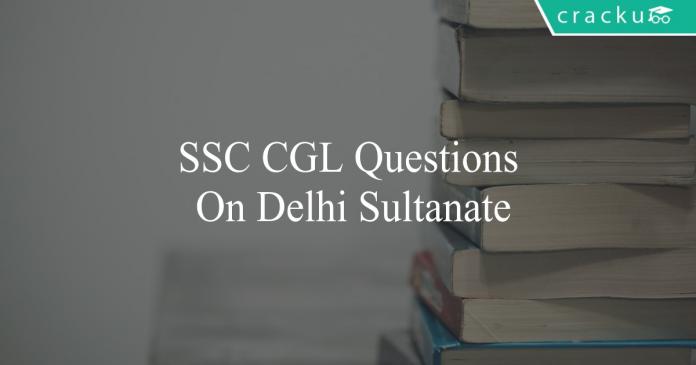SSC CGL Questions On Delhi Sultanate
Download SSC CGL Delhi Sultanate questions with answers PDF based on previous papers very useful for SSC CGL exams. 15 Very important Delhi Sultanate objective questions for SSC exams.
Download SSC CGL Questions On Delhi Sultanate
Question 1: What was the official language of Delhi Sultanate?
a) Afghani
b) Urdu
c) Persian
d) Arabic
Question 2: Who defeated Ibrahim lodi, the last sultanate of delhi in the battle of Panipat?
a) Hyder Ali
b) Akbar
c) Tipu Sultan
d) Babur
Question 3: Which university was built by King Dharmapala. This university was later destroyed during an attack by Bakhtiyar Khilji of the Delhi Sultanate.
a) Sompuri
b) Vikramashila
c) Jagdal
d) Takshashila
Question 4: During Delhi Sultanate rule, what is the state/province called as?
a) Manyam
b) Grama
c) Iqta
d) Suba
Question 5: Which Turkish Delhi Sultanate ruler separated religion from politics?
a) Alauddin Khilji
b) Jalaluddin Khilji
c) Qutubuddin Aibak
d) Iltumish
Question 6: Under Delhi Sultanate administration, who is the head of the Department Of Finance?
a) Muqti
b) Amil
c) Chaudhary
d) Wazir
Question 7: Who among the following did not ruled the Delhi Sultanate?
a) Slave dynasty
b) Syed dynasty
c) Khilji dynasty
d) Ghori dynasty
Question 8: Ibrahim Lodi, the last Sultan of Delhi Sultanate is the son of which famous ruler?
a) Sikandar Lodi
b) Mahmud Lodi
c) Bahlul Lodi
d) Malik Sultan Shal Lodi
Question 9: Who among the following, The Sultan of Sultanate of Delhi has transferred his capital from Delhi to Agra?
a) Sikandar Lodi
b) Osman Ali Khan
c) khizr Khan
d) Muhammad Bin Tuglaq
Instructions
The greatest flourishing of northern Indian culture, art, and imperial strength undoubtedly took place during the reign of the Mughal monarchs of the 16th and 17th centuries. The Mughals were Central Asian descendents of the great Mongol warriors Ghengis Khan and Timur (Tamerlane), whose hordes of cavalry swept across the Eurasian steppe in the 13th and 14th centuries, conquering everything between Beijing and Budapest. But by the turn of the 16th century, the great Mongol empire has splintered: the many royal descendents of Ghengis and Timur fought over the territorial scraps and did their best to hold’ on to their own minor Sultanates.
One of these Sultans. Babur, was not satisfied with his small kingdom of Ferghana (now in modern-day Kyrgyzstan and eastern Uzbekistan), and he tried and tried again to permanently reconquer Timur’s greatest prize, Samarkand. He never succeeded. So instead, Babur turned his attention south to the Sultanate of Delhi in northern India. which had been ruled successively by five dynasties of Muslim warriors from Afghanistan since the late It century. As history would show, Babur’s campaign against the Delhi Sultanate catalyzed the foundation of one of the greatest dynasties in the history of South Asia : the Mughal Empire.
Question 10: the word closet in meaning to catalyzed is
a) unrestricted
b) exploited
c) disseminated
d) accelerated
18000+ Questions – Free SSC Study Material
Question 11: the mmongols in the 13th and 14th centuries
a) plundered the greater part of asia and eastern europe
b) gave rise to the mughal dynasty
c) encouraged imperial strength in northern india
d) none of the above
Question 12: the mughal rulers were responsible for
a) unleashing terror amongst their subjects
b) organizing the eurasian stepe region
c) patronizing art and culture
d) in-fighting amongst themselves
Question 13: The mughal attacked the delhi sultanate because
a) they were the royal descendants of ghengis khan
b) they wanted to expand their kingdom
c) they could not gain suprremacy in the kingdom of samarkand
d) both (B) and (C)
Question 14: The mughals can trace their ancestry to
a) beijing
b) budapest
c) central asia
d) the eurasian steppes
Question 15: Who is the author of the book ‘Women of Vision’?
a) Ravinder Singh
b) Preeti Shenoy
c) Amish Tripathi
d) Alam Srinivas
Answers & Solutions:
1) Answer (C)
2) Answer (D)
3) Answer (B)
4) Answer (C)
5) Answer (A)
6) Answer (D)
7) Answer (D)
d:
8) Answer (A)
9) Answer (A)
10) Answer (D)
11) Answer (B)
12) Answer (B)
13) Answer (E)
14) Answer (C)
15) Answer (D)





